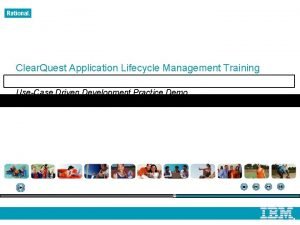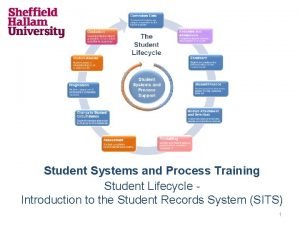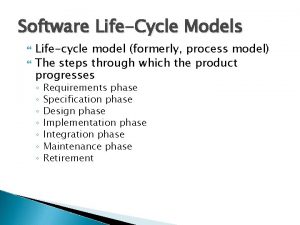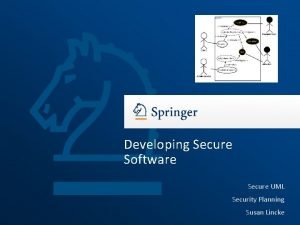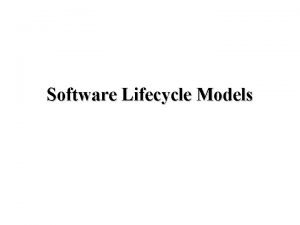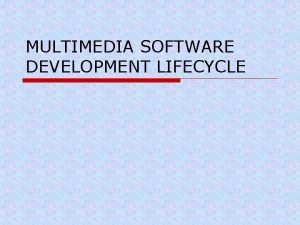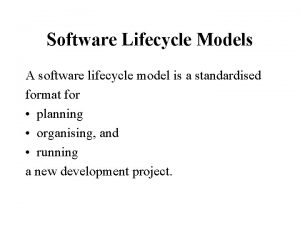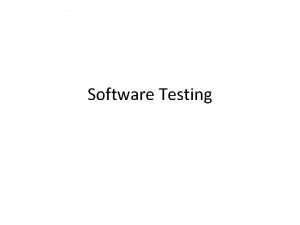SOFTWARE TESTING TRAINING TESTING THROUGHOUT THE TESTING LIFECYCLE














- Slides: 14

SOFTWARE TESTING TRAINING TESTING THROUGHOUT THE TESTING LIFECYCLE Chapter 2 immaculateres 1

WHAT IS VERIFICATION IN SOFTWARE TESTING? OR WHAT IS SOFTWARE VERIFICATION? What is Verification in software testing? or What is software verification? • It makes sure that the product is designed to deliver all functionality to the customer. • Verification is done at the starting of the development process. It includes reviews and meetings, walkthroughs, inspection, etc. to evaluate documents, plans, code, requirements and specifications. • It is a Low level activity. • Demonstration of consistency, completeness, and correctness of the software at each stage and between each stage of the development life cycle. • Verification means ensuring that the software has been built correctly. “Confirmation by examination and through provision of objective evidence that specified requirements have been fulfilled. “ 2 immaculateres

WHAT IS VALIDATION IN SOFTWARE TESTING? OR WHAT IS SOFTWARE VALIDATION? • What is Validation in software testing? or What is software validation? • Determining if the system complies with the requirements and performs functions for which it is intended and meets the organization’s goals and user needs. • Validation is done at the end of the development process and takes place after verifications are completed. • It is a High level activity. • Determination of correctness of the final software product by a development project with respect to the user needs and requirements. • Validation: Validation means ensuring that the software meets the requirements, both the stated and implied. “Confirmation by examination and through provision of objective evidence that the requirements for a specific intended use or application have been fulfilled. “ immaculateres 3

SOFTWARE DEVELOPMENT MODELS SEQUENTIAL DEVELOPMENT MODEL: WATERFALL MODEL SEQUENTIAL DEVELOPMENT MODEL: • In a waterfall model, each phase must be completed fully before the next phase can begin. At the end of each phase, a review takes place to determine if the project is on the right path and whether or not to continue or discard the project. In this model the testing starts only after the development is complete. In waterfall model phases do not overlap. 4 immaculateres

SOFTWARE DEVELOPMENT MODELS SEQUENTIAL DEVELOPMENT MODEL: V_MODEL • V- model means Verification and Validation model. Just like the waterfall model, the VShaped life cycle is a sequential path of execution of processes. Each phase must be completed before the next phase begins. Testing of the product is planned in parallel with a corresponding phase of development in V_model. come 5 immaculateres

SOFTWARE DEVELOPMENT MODELS INCREMENTAL MODEL: RAPID APPLICATION DEVELOPMENT MODEL • In RAD model the components or functions are developed in parallel as if they were mini projects. The developments are time boxed, delivered and then assembled into a working prototype. This can quickly give the customer something to see and use and to provide feedback regarding the delivery and their requirements. immaculateres 6

SOFTWARE DEVELOPMENT MODELS INCREMENTAL MODEL: AGILE MODEL • Software is developed in incremental, rapid cycles. This results in small incremental releases with each release building on previous functionality. Each release is thoroughly tested to ensure software quality is maintained. It is used for time critical applications. immaculateres 7

SOFTWARE DEVELOPMENT MODELS ITERATIVE MODEL: SPIRAL MODEL • The spiral model has four phases: • Planning Phase: Requirements are gathered during the planning phase. Requirements like ‘BRS’ that is ‘Business Requirement Specifications’ and ‘SRS’ that is ‘System Requirement specifications’. • Risk Analysis: In the risk analysis phase, a process is undertaken to identify risk and alternate solutions. A prototype is produced at the end of the risk analysis phase. If any risk is found during the risk analysis then alternate solutions are suggested and implemented. • Engineering Phase: In this phase software is developed, along with testing at the end of the phase. Hence in this phase the development and testing is done. • Evaluation phase: This phase allows the customer to evaluate the output of the project to date before the project continues to the next spiral. immaculateres 8

SOFTWARE DEVELOPMENT MODELS ITERATIVE MODEL: PROTOTYPE MODEL • The basic idea here is that instead of freezing the requirements before a design or coding can proceed, a throwaway prototype is built to understand the requirements. This prototype is developed based on the currently known requirements. By using this prototype, the client can get an “actual feel” of the system, since the interactions with prototype can enable the client to better understand the requirements of the desired system. immaculateres 9

SOFTWARE TESTING LEVELS • Testing levels are basically to identify missing areas and prevent overlap and repetition between the development life cycle phases. In software development life cycle models there are defined phases like requirement gathering and analysis, design, coding or implementation, testing and deployment. Each phase goes through the testing. Hence there are various levels of testing. • The various levels of testing are: • Unit testing: It is basically done by the developers to make sure that their code is working fine and meet the user specifications. They test their piece of code which they have written like classes, functions, interfaces and procedures. • Component testing: It is also called as module testing. The basic difference between the unit testing and component testing is in unit testing the developers test their piece of code but in component testing the whole component is tested. For example, in a student record application there are two modules one which will save the records of the students and other module is to upload the results of the students. Both the modules are developed separately and when they are tested one by one then we call this as a component or module testing. • Integration testing: Integration testing is done when two modules are integrated, in order to test the behavior and functionality of both the modules after integration. Below are few types of integration testing: • Big bang integration testing • Top down • Bottom up • Functional incremental 10 immaculateres

SOFTWARE TESTING LEVELS • Component integration testing: In the example above when both the modules or components are integrated then the testing done is called as Component integration testing. This testing is basically done to ensure that the code should not break after integrating the two modules. • System integration testing: System integration testing (SIT) is a testing where testers basically test that in the same environment all the related systems should maintain data integrity and can operate in coordination with other systems. • System/Functional testing: In system testing the testers basically test the compatibility of the application with the system. • Acceptance testing: Acceptance testing are basically done to ensure that the requirements of the specification are met. • Alpha testing: Alpha testing is done at the developers site. It is done at the end of the development process • Beta testing: Beta testing is done at the customers site. It is done just before the launch of the product. 11 immaculateres

SOFTWARE TEST TYPES • A test type is focused on a particular test objective, which could be the testing of the function to be performed by the component or system; a non-functional quality characteristics, such as reliability or usability; the structure or architecture of the component or system; or related to changes, i. e confirming that defects have been fixed (confirmation testing or retesting) and looking for unintended changes (regression testing). • There are four software test types: 1) Functional Testing: In functional testing basically the testing of the functions of component or 1) Functional Testing: system is done. It refers to activities that verify a specific action or function of the code. Functional test tends to answer the questions like “can the user do this” or “does this particular feature work”. This is typically described in a requirements specification or in a functional specification. 2) Non Functional Testing: In non-functional testing the quality characteristics of the component or system is tested. Non-functional refers to aspects of the software that may not be related to a specific function or user action such as scalability or security. Eg. How many people can log in at once? Non-functional testing is also performed at all levels like functional testing. 12 immaculateres

SOFTWARE TEST TYPES (CONT’D) 3) The structural testing is the testing of the structure of the system or component. Structural testing is often referred to as ‘white box’ or ‘glass box’ or ‘clear-box testing’ because in structural testing we are interested in what is happening ‘inside the system/application’. In structural testing the testers are required to have the knowledge of the internal implementations of the code. Here the testers require knowledge of how the software is implemented, how it works. 4) Testing Related to Change: • Confirmation testing or re-testing: When a test fails because of the defect then that defect is reported and a new version of the software is expected that has had the defect fixed. In this case we need to execute the test again to confirm that whether the defect got actually fixed or not. This is known as confirmation testing and also known as retesting. It is important to ensure that the test is executed in exactly the same way it was the first time using the same inputs, data and environments. 13 immaculateres

SOFTWARE TEST TYPES (CONT’D) • Regression Testing: When any modification or changes are done to the application or even when any small change is done to the code then it can bring unexpected issues. Along with the new changes it becomes very important to test whether the existing functionality is intact or not. This can be achieved by doing the regression testing. • The purpose of the regression testing is to find the bugs which may get introduced accidentally because of the new changes or modification. • During confirmation testing the defect got fixed and that part of the application started working as intended. But there might be a possibility that the fix may have introduced or uncovered a different defect elsewhere in the software. The way to detect these ‘unexpected side-effects’ of fixes is to do regression testing. • Impact Analysis/Testing: Impact analysis is basically analyzing the impact of the changes in the deployed application or product. It tells us about the parts of the system that may be unintentionally affected because of the change in the application and therefore need careful regression testing. This decision is taken together with the stakeholders. immaculateres 14
 Software testing lifecycle
Software testing lifecycle Application lifecycle management training
Application lifecycle management training Student lifecycle management
Student lifecycle management Agile product lifecycle management software
Agile product lifecycle management software Student lifecycle model
Student lifecycle model Software lifecycle models
Software lifecycle models Secure uml
Secure uml What is domain test
What is domain test Motivational overview in software testing
Motivational overview in software testing Data flow testing strategies in software testing
Data flow testing strategies in software testing What is globalization testing
What is globalization testing Cause effect graph for triangle problem
Cause effect graph for triangle problem Control structure testing in software testing
Control structure testing in software testing Decision table testing in software testing
Decision table testing in software testing Decision table testing
Decision table testing

